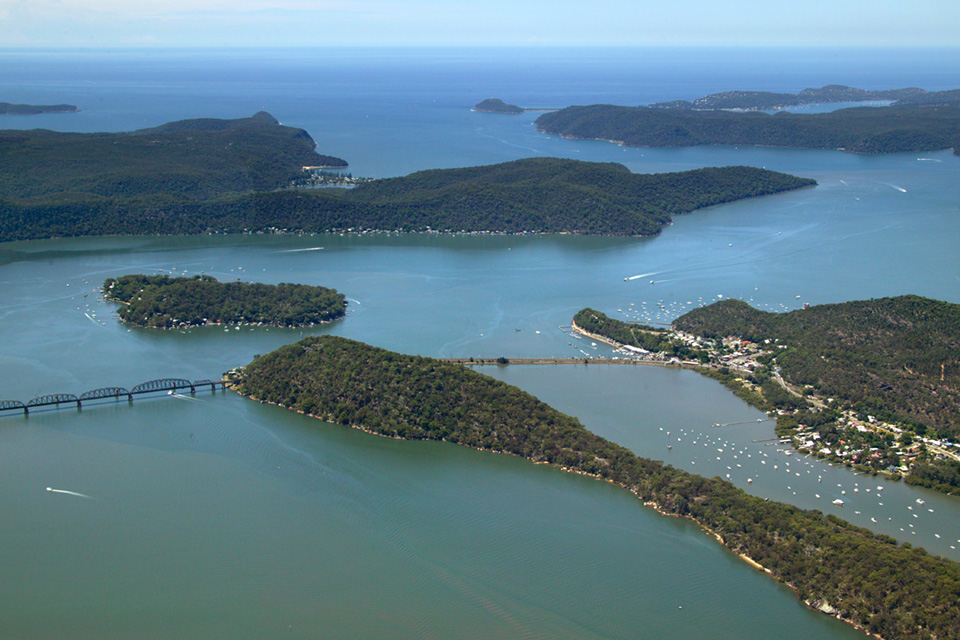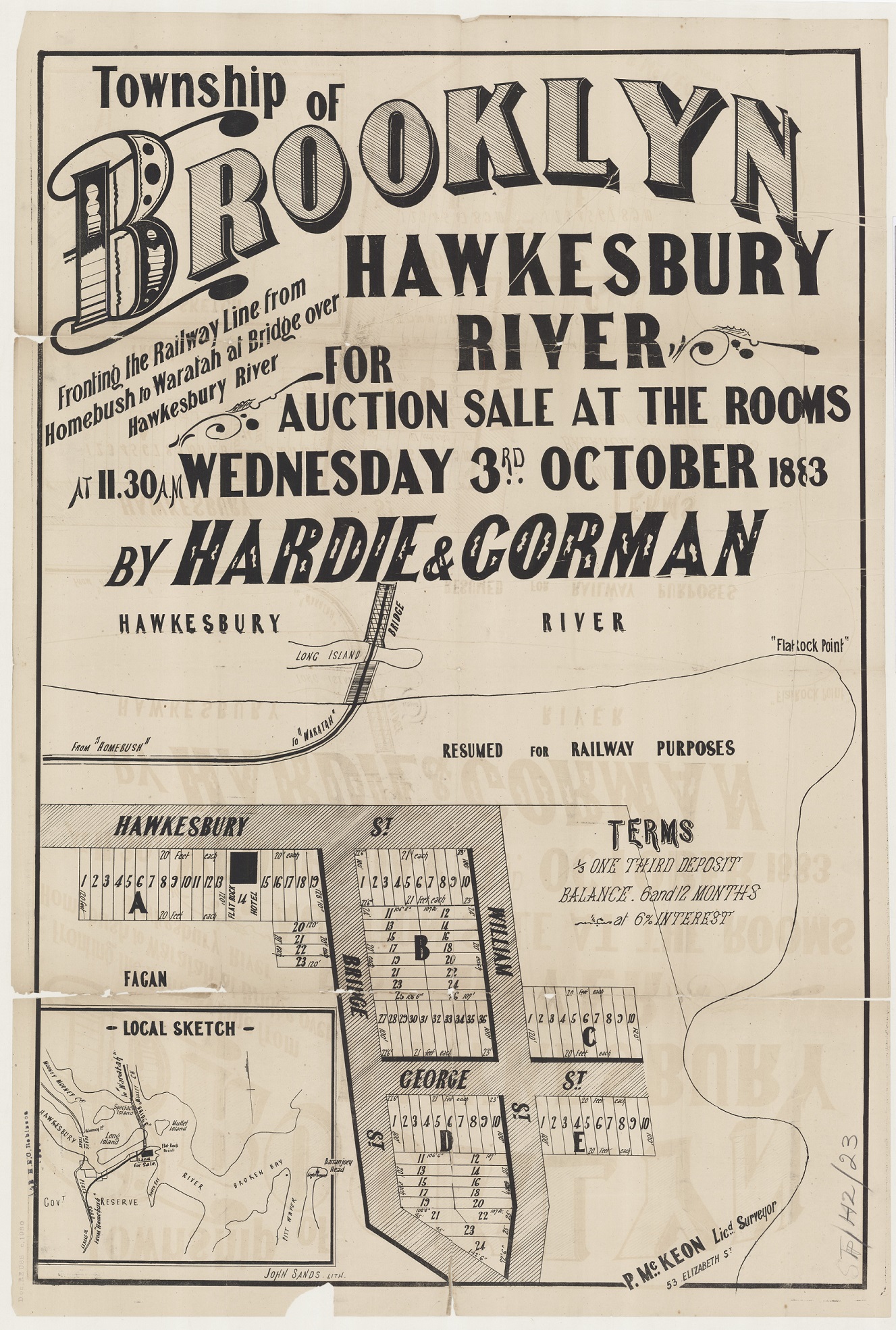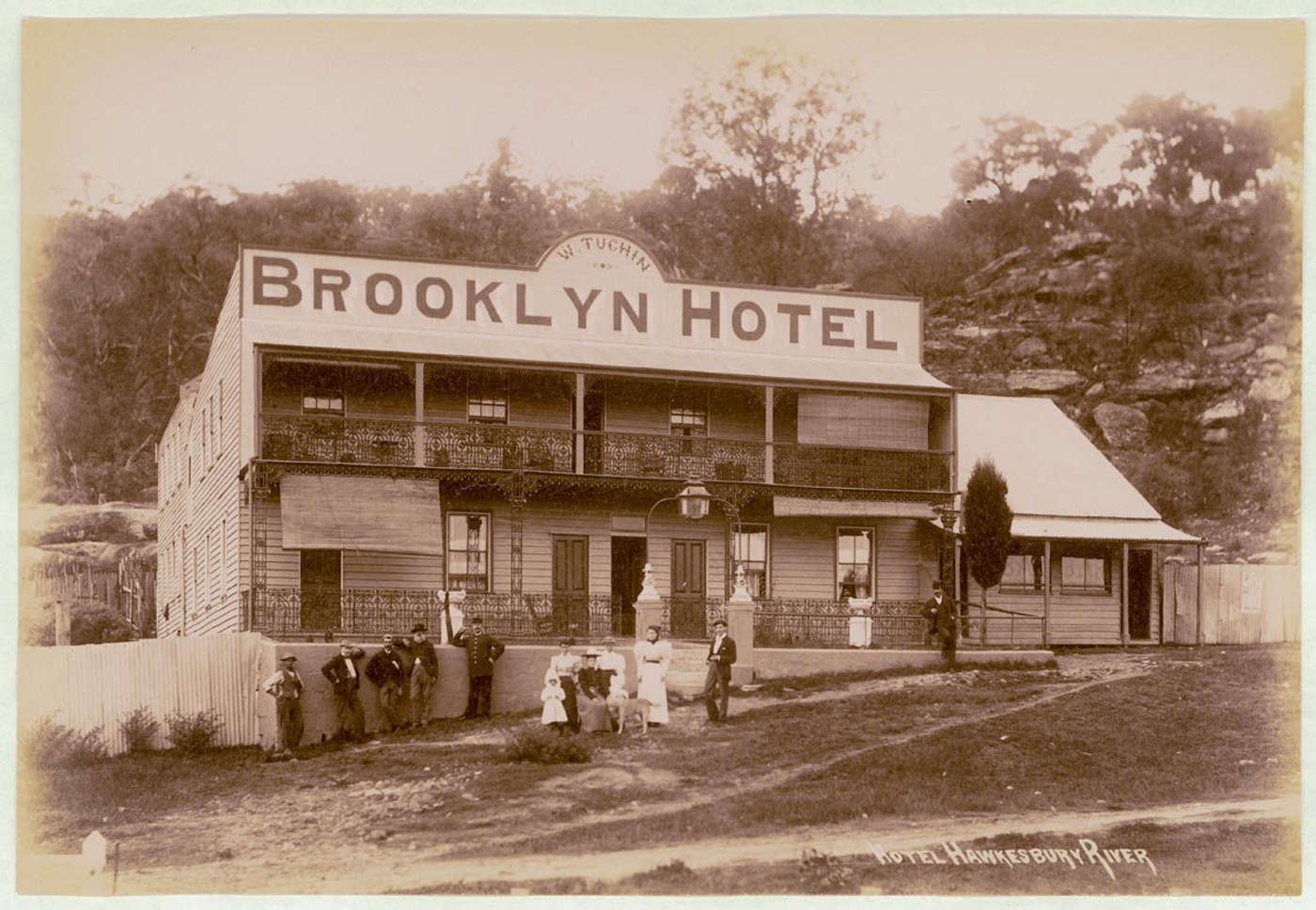The Dictionary of Sydney was archived in 2021.
Brooklyn
Citation
Persistent URL for this entry
To cite this entry in text
To cite this entry in a Wikipedia footnote citation
To cite this entry as a Wikipedia External link
Brooklyn
[media]The original inhabitants of this area were the Aboriginal people who spoke a common language and lived in the area from Port Jackson north across Broken Bay and along the Central Coast.
Brooklyn, in the parish of Cowan, was once known as the Village of Brooklyn and also Bywater. The National Geographic Names Board of New South Wales regards Bywater as a variant placename for Brooklyn.
The first voyage of exploration up the Hawkesbury River reached the vicinity of Brooklyn in 1788, when Governor Phillip arrived at an island which he named Mullet Island (now Dangar Island).
Early landholders
[media]The earliest recorded settler on this part of the Hawkesbury River was George Peat, who acquired property on Mooney Mooney Point in 1831, and received a grant of 50 acres (20 hectares) of land in 1836. [1] He quickly extended his holdings to include Kangaroo Point and Peat's Crater, in what is now Muogamarra Nature Reserve. By 1850, James Cole, who became a mail contractor, had settled at Mooney Mooney. In 1862, Vincent William Seymour became the first landholder on the Brooklyn side; James Cole and James Ross were other early settlers at Brooklyn. [2]
The Gosford District Local History Study Group found that Brooklyn stands on a grant of 100 acres (40 hectares) made to Francis King and Richard Robinson in 1840.
The settlers at Brooklyn were in a remote location, as the main settlement was around Bar Island. The construction of the railway changed this, and Brooklyn developed as an important railway town.
[media]The Geographical Names Board of New South Wales has accepted that Brooklyn was so named because the Union Bridge Company of Brooklyn, New York, built both the New York Brooklyn Bridge and the first railway bridge across the Hawkesbury River however the bridges were built by two different companies, and the name Brooklyn was in use well before construction of the bridge across the Hawkesbury had commenced. In 1883, 108 allotments of land in Brooklyn were being advertised for sale ''destined to become a thriving and important commercial township', within a few yards of the site of the proposed bridge. [3] In 1885 Agnes Fagan, wife of Samuel Fagan, a land owner in the Galston and Arcadia districts, described her visit to the area, mentioning that she stayed at the Brooklyn Hotel. Originally named the Flat Rock Hotel, the proprieter had successfully applied to the licensing court in July 1884 to change its name to the Brooklyn Hotel. And the name Brooklyn first appears in an official document in 1884, when Daniel Murphy was asked to carry out a survey for the town of Brooklyn. [4]
At the time of Mrs Fagan's visit to Brooklyn in 1885, there was a school, police station, hall and the Brooklyn Hotel, as well as a wharf built to take the supplies for the contractors of the railway. [5]
Brooklyn and Federation
In 1887 the first trains reached Brooklyn, and in 1889 the railway bridge was completed. During the ensuing celebrations, Sir Henry Parkes gave an important speech on the need for federation of the colonies.
The name of the station at Brooklyn changed back and forth, from Hawkesbury River, to Brooklyn, then Hawkesbury, before it was finally decided in 1906 to retain the name Hawkesbury River.
The village of Brooklyn grew quickly, with the railway station as its focal point. It became a base for the tourist and fishing industries, as the railway provided a fast method of transporting produce to the city markets and allowed easy day excursions from Sydney to banks of the Hawkesbury River.
The village hosted the ship Lucinda, on which the constitution of Australia was drafted in 1891. It also welcomed the Duke and Duchess of York in 1901, when the royal yacht anchored off Juno Point. Brooklyn was then a well-known spot, acknowledged when a view looking over the old Sanatorium Hotel was used on the first £5 note issued by the Commonwealth Government, in 1913. [6]
There is growing recognition of Brooklyn's significance in the Federation movement. In 2001, Hornsby Shire Council opened a historical interpretive display at McKell Park, Brooklyn, showing the links to the movement.
This entry was revised on 18 May 2018 to include new information about the Union Bridge Company and references to the name of Brooklyn.
Notes
[1] Hornsby Historical Society, Pioneers of Hornsby Shire 1788-1906, Library of Australia, Sydney, 1980, p 29
[2] Hornsby Historical Society, Pioneers of Hornsby Shire 1788-1906, Library of Australia, Sydney, 1980, p 32
[3] Hawkesbury River Railway Bridge, Sydney Morning Herald, 29 September 1883, 15
[4] Parramatta Licensing Court, The Cumberland Mercury, 23 July 1884, p 2; Noel E Johnson, History of Brooklyn, the author, Brooklyn NSW, 1993, p 9
[5] Tom Richmond, 'Birth of Brooklyn', Local Colour, vol 6 no 8, p 23
[6] Tom Richmond, Brooklyn, Federation Village. Brooklyn's Link with the Federation Movement in Australia, the author, Brooklyn NSW, 2001, p 5
.





